
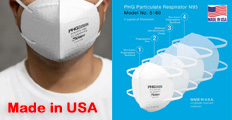


Find all of your laboratory and workplace safety supplies at Safety Emporium!
 DOT |
 Glossary Index |
 Dyspnea |
| MSDS Topics |
Free Sites | FAQ's | Regulations | Glossary | Software | Suppliers |
| Books | Forum | Poll | Fun stuff | Quiz | Store | |
| Understand your MSDS with the MS-Demystifier | Search ALL our MSDS info | |||||
A dust is fine (small) particles of dry matter. Dusts can be generated by handling, crushing, grinding, rapid impact, detonation, and breakdown of certain organic or inorganic materials, such as rocks, ore, metal, coal, wood, plastic, and food grains.
Dusts can form a cloud or suspension in air, but the material tends to settle to the ground evenly rather than diffuse (migrate) throughout an area like a vapor. Dusts do not tend to flocculate (clump together in fluffy masses). The term fumes is sometimes used to refer to airborne dusts.
Dusts are different than vapors and mists. Dusts are comprised of solid particles, each of which consists of large number of atoms or molecules of a material that is not normally volatile. Of course, dusts and vapors may sometimes be intermingled.
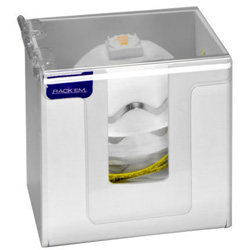
Encourage dust mask and other protective equipment use with safety dispensers from Safety Emporium.
Dust particles may be small enough that they are respirable, capable of being drawn deep into the lungs when you take a breath. Some dusts, such as certain forms of asbestos and coal dust, remain lodged deep inside the lungs where they can eventually cause cancer or other chronic health effects such as emphysema, pneumoconiosis and bronchitis. For example, the American Cancer Society has stated that exposure to asbestos in combination with cigarette smoking increases an individual's lung cancer risk nearly 60 times. At the very least, most dusts are respiratory irritants.
Even "natural" products such as moldy hay, bird droppings etc. contain spores that can cause a variety of nasty lung diseases as well. Woodworkers should pay attention to Clarification of OSHA's Hazard Communication Standard with regards to the carcinogenicity of wood dust, too.
Other dusts can form explosive mixtures in air. One doesn't ordinarily think about everyday items such as flours or grain as being explosive. But when these combustible materials are reduced to a dust, they have an extremely high surface area and can burn quite rapidly. When the concentrations of air and dust fall within the explosive limits and are ignited, the resulting fire and explosion can be astounding. Essentially any material that can burn can explode as a dust!
Grain dust explosions are quite powerful and often deadly. Take a look at the aftermath of a deadly accident. FM Global posted a short video of a live dust explosion to demonstrate the power of such explosions.
A 2006 study by the US Chemical Safety Board found 281 dust fires and explosions over a 25-year period that took 119 lives and caused 718 injuries. 24% of those were in the food industry. 71% of the incidents resulted in injuries or fatalities. See why an SDS for sugar isn't as silly as most people think? In 2018, the CSB identified another 105 combustible dust incidents that occurred since the 2006 study.
According to the NFPA, a catastrophic explosion can occur from as little as 1/32 inch (0.8 mm) of accumulated dust, around the thickness of a dime, covering just 5% of a room's surface area.
Dust explosions differ from conventional fires in that they require five elements rather than three:
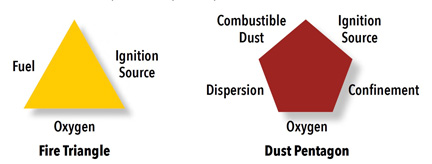
Keep in mind that dust explosions can kick up even more dust, making them auto-catalytic in nature, and greatly increasing the force of the original event.
In light of the 2006 CSB study mentioned above, there were calls for OSHA to issue a combustible dust standard. A rather polarized debate attracted attention in the US Congress, and finally, in 2009, OSHA announced it was initiating a comprehensive rulemaking on combustible dust. On November 10, 2009, OSHA published an advanced notice of proposed rule-making covering dust in the workplace which began with informal stakeholder meetings in Washington, DC from December 14th, 2009 through April 2010. This was followed by an expert forum in May of 2011. Unfortunately, the next step of the rulemaking process, convening of a Small Business Regulatory Enforcement Fairness Act (SBREFA) panel to ensure that any such regulation would not unduly burden small businesses, was postponed repeatedly and OSHA formally withdrew its rulemaking proposal on March 30, 2017.
While a Combustible Dust Standard for general industry is now unlikely under the current political climate, OSHA has incorporated combustible dusts into other regulations, most notably 29 CFR 1910.1200, the OSHA Hazard Communication Standard, which regulates the content of SDS's. Specifically, the standard defines a combustible dust as a hazardous chemical meaning that such characteristics must be taken into account when performing the hazard classification process.
Still, this is a far cry from comprehensive legislation that would require workplaces to come up with a dust control plan and install infrastructure (ventilation equipment, monitoring etc.) that could prevent deadly dust explosions. To keep informed about updates to the rulemaking process see the Chemical Safety Board's rulemaking watch on OSHA's Combustible Dust Standard.
NOTE: We may collect a share of sales or other compensation from the links in the following list:
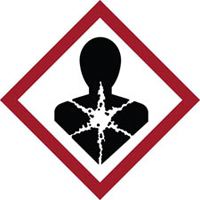
Get your GHS-compliant labels and signs from Safety Emporium.
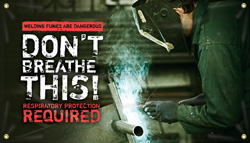
Welding fumes are also a respiratory hazard. Remind your employees with safety banners from Safety Emporium.
If applicable, Safety Data Sheets will provide information regarding how to avoid the formation of dust or precautions you should take when working with dusts of the material. Three general ways to avoid being exposed to dusts are:
The 2012 update to OSHA's Hazard Communication Standard classifies combustible dusts as hazardous chemicals. Therefore, if the substance presents such a hazard, the SDS should inform you. Broad classes of products that pose a combustible dust hazard include agricultural products, carbonaceous dusts, chemical dusts, metal dusts, and plastic dusts. OSHA has a handy fact sheet that lists products and materials with combustible dust explosion potential.
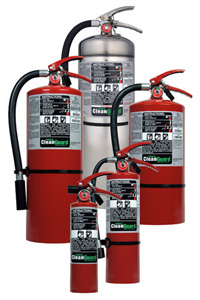
Fire safety is a must around dust. Protect your workplace with fire extinguishers from Safety Emporium.
See also: Asthma, fume, smoke.
Additional definitions from Google and OneLook.
Entry last updated: Sunday, July 10, 2022. This page is copyright 2000-2025 by ILPI. Unauthorized duplication or posting on other web sites is expressly prohibited. Send suggestions, comments, and new entry desires (include the URL if applicable) to us by email.
Disclaimer: The information contained herein is believed to be true and accurate, however ILPI makes no guarantees concerning the veracity of any statement. Use of any information on this page is at the reader's own risk. ILPI strongly encourages the reader to consult the appropriate local, state and federal agencies concerning the matters discussed herein.